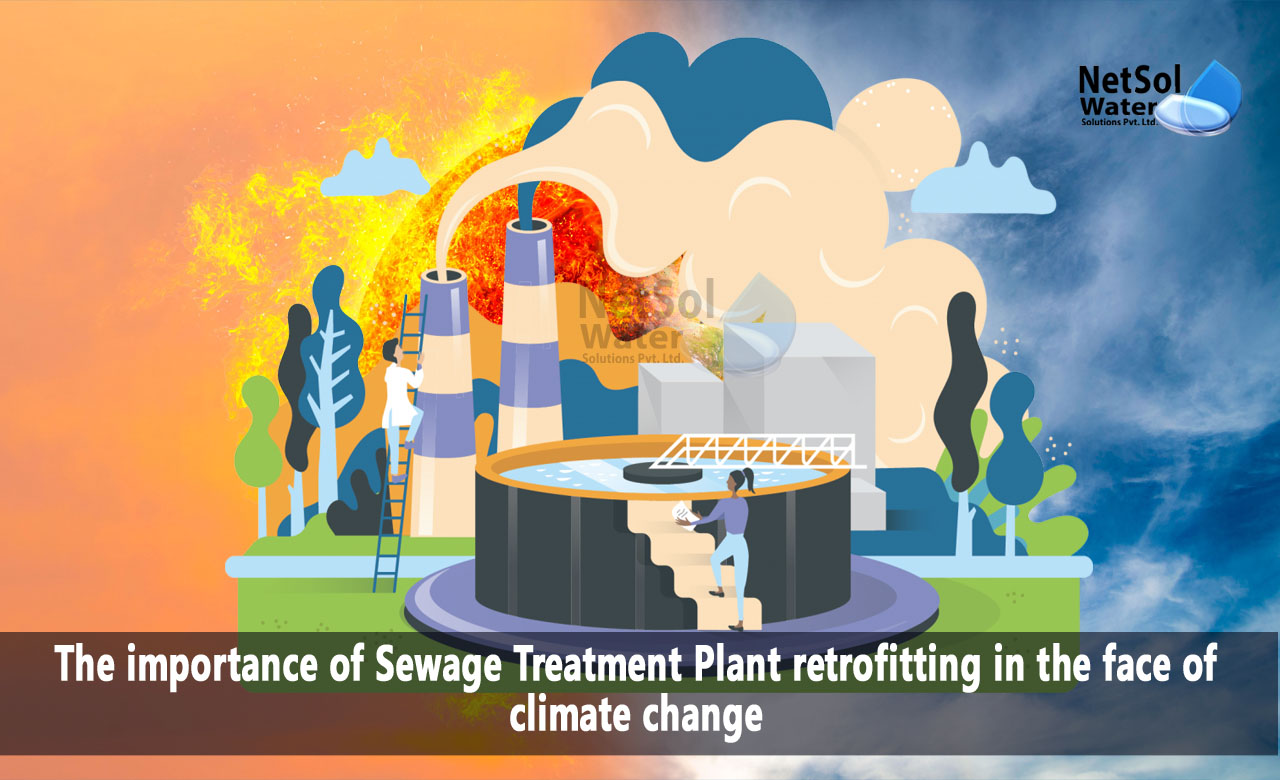The importance of STP Plant retrofitting in the face of climate change
Climate change poses significant challenges to infrastructure systems, including sewage treatment plants (STPs). Rising sea levels, increased storm intensity, and changing precipitation patterns can impact the effectiveness and reliability of STPs. Retrofitting existing STPs is crucial to enhance their resilience and adapt to the changing climate.
Here we will explore the importance of sewage treatment plant retrofitting in the face of climate change and highlights key strategies for building resilience.
Understanding the Impact of Climate Change on STPs
1. Sea Level Rise:
As sea levels rise, coastal STPs are at risk of saltwater intrusion into the wastewater collection and treatment systems. This intrusion can disrupt biological treatment processes, affect the efficiency of disinfection, and increase the corrosion of infrastructure.
2. Extreme Weather Events:
Climate change leads to more frequent and intense storms, causing heavy rainfall and flooding. STPs must be prepared to handle increased volumes of stormwater and prevent overflow events that can lead to untreated sewage discharges into water bodies.
3. Changing Precipitation Patterns:
Changes in precipitation patterns, such as prolonged droughts or intense rainfall events, affect the inflow and quality of wastewater entering the treatment plant. STPs need to be adaptable to handle variations in wastewater flow and composition.
Retrofitting Strategies for Climate Resilience
1. Infrastructure Upgrades:
Retrofitting STPs involves upgrading infrastructure components to withstand climate-related stresses. This includes raising the elevation of critical equipment and structures to mitigate the risk of flooding, using corrosion-resistant materials, and reinforcing vulnerable areas.
2. Stormwater Management:
Implementing stormwater management strategies is crucial to handle increased rainfall and reduce the risk of overflows. Green infrastructure solutions, such as rain gardens, permeable pavement, and constructed wetlands, can help absorb and manage stormwater runoff, reducing the burden on the STP.
3. Backup Power Systems:
Climate-related events can disrupt power supply, leading to potential STP failures. Installing backup power systems, such as generators or renewable energy sources, ensures uninterrupted operation during power outages, minimizing the risk of untreated sewage discharges.
4. Adaptive Treatment Processes:
Retrofitting should focus on enhancing the adaptability of treatment processes. This can involve incorporating modular treatment units that can be easily expanded or adjusted based on changing wastewater characteristics. Additionally, implementing advanced treatment technologies, such as membrane filtration or UV disinfection, can improve treatment efficiency and provide additional safeguards.
5. Monitoring and Early Warning Systems:
Retrofitting should include the installation of robust monitoring systems to track changes in water levels, flow rates, and water quality parameters. Early warning systems can help identify potential risks and allow for proactive measures to mitigate their impacts.
6. Community Engagement and Education:
Collaboration with the local community is vital for building climate resilience. Engaging the community in understanding the importance of STP retrofitting, promoting water conservation practices, and providing information on climate change impacts fosters a sense of ownership and resilience within the community.
Benefits of STP Retrofitting for Climate Resilience
1. Improved System Reliability:
Retrofitting enhances the reliability of STPs, reducing the risk of system failures and ensuring continuous wastewater treatment even in challenging climate conditions.
2. Environmental Protection:
Climate-resilient STPs help prevent untreated sewage discharges into water bodies, protecting aquatic ecosystems and public health.
3. Adaptability and Flexibility:
Retrofitting allows STPs to adapt to changing climate conditions and handle variations in wastewater characteristics, ensuring efficient treatment regardless of external factors.
4. Cost-Effectiveness:
Investing in retrofitting early can save long-term costs associated with system failures, emergency repairs, and environmental remediation.
Summary:
Sewage treatment plant retrofitting is essential for enhancing resilience to climate change. By implementing infrastructure upgrades, stormwater management strategies, backup power systems, adaptive treatment processes, and robust monitoring systems, STPs can withstand the impacts of climate change and continue to provide effective wastewater treatment. Retrofitting not only improves system reliability but also protects the environment and promotes sustainable and resilient communities. Embracing these strategies today will ensure that STPs are prepared for the challenges of tomorrow's changing climate.
Leading manufacturer of sewage treatment plants in India.
Netsol Water is the leading manufacturer, supplier, and exporter of a quality selection of water treatment, and wastewater treatment products in India, by using advanced sewage treatment methods.
RO plants, water softeners, ETPs, STPs, DM plants, AMC, O&M, Ultra filtration, UV, Ozonation, ZLD plants, Anoxic tanks, and other goods and services are available from us. We also provide services to businesses in sectors including automotive, pharmaceutical, textile, pulp & paper, beverages, refineries, schools, hospitals, office buildings, and hotels, among others.
Netsol Water is Greater Noida-based leading water & wastewater treatment plant manufacturer. We are industry's most demanding company based on client review and work quality. We are known as best commercial RO plant manufacturers, industrial RO plant manufacturer, sewage treatment plant manufacturer, Water Softener Plant Manufacturers and effluent treatment plant manufacturers. Apart from this 24x7 customer support is our USP. Call on +91-9650608473, or write us at enquiry@netsolwater.com for any support, inquiry or product-purchase related query.



